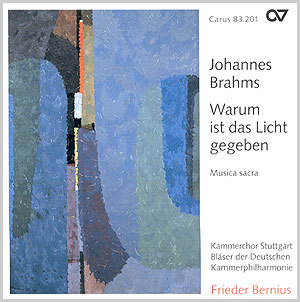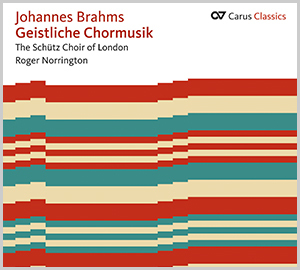
Warum ist das Licht gegeben. Musica sacra (Bernius)
Awarded the Diapason d'Or
Contents
-
Composer
Johannes Brahms
| 1833-1897Johannes Brahms' study of musical tradition was of crucial importance to his output: he combined church modes, canonic technique, Baroque style and diction, Bach's counterpoint and Beethoven's thematic-motivic work with the harmonic and expressive achievements of Romanticism to form his own distinctive style. In this respect his choral songs and vocal quartets (e.g. the “Liebeslieder Waltzes” and “New Liebeslieder Waltzes”), often to folk song texts, in which a musical microcosm unfolds, are examplary. His “Deutsches Requiem”, available from Carus in several different versions, constitutes one of the most fascinating confessions of faith in the history of music. Personal details
-
Preface writer
Michael Musgrave
| 1942
-
Choir
Kammerchor Stuttgart
The Kammerchor Stuttgart is regarded as one of the best ensembles of its kind. Over its fifty-year existence, Frieder Bernius has developed the choir into an exceptional ensemble acclaimed by audiences and press alike. This has led to invitations for the choir to perform at all the important European festivals. In Germany the chamber choir performs at festivals and in concert halls in repertoire ranging from the 17th to the 21st century. Frieder Bernius and his ensemble have received numerous accolades for their contribution to new music. The Kammerchor Stuttgart has made over 80 CDs and LPs, numerous of which have been awarded international recording prizes (including the Edison award, Diapason d’or, Gramophone Choice, Classical Internet Award, International Classical Music Award, and German Record Critics’ Award prizes). The International Federation for Choral Music has invited the ensemble to sing at the 1st, 4th and 10th World Symposia on Choral Music in Vienna, Sydney and Seoul. Regular tours of North America and Asia since 1988 and a South America tour reflect the Kammerchor Stuttgart’s international reputation. Since 1984 the top ensemble has also been invited to Israel biennially. Personal details
-
Ensemble
Bläser der Deutschen Kammerphilharmonie
-
Conductor
Frieder Bernius
| 1947Frieder Bernius’s work has earned great worldwide recognition. He is in demand internationally as a conductor and as a teacher. His principal artistic collaborators are the ensembles he founded himself, the Kammerchor Stuttgart, the Barockorchester Stuttgart, the Hofkapelle Stuttgart and the Klassische Philharmonie Stuttgart. As a guest conductor, he has collaborated repeatedly with, for example, the SWR Vokalensemble Stuttgart, the Deutsche Kammerphilharmonie Bremen, the Stuttgarter Kammerorchester and the Streicherakademie Bozen. Great stylistic versatility is Frieder Bernius’s hallmark. Whether he conducts vocal works by Monteverdi, Bach, Händel, Mozart, Beethoven, Fauré and Ligeti, stage music by Mendelssohn or symphonies by Haydn, Burgmüller and Schubert, his work always aims for a sound that is at once unmistakably personal and at the same time oriented towards the original period sound ideal. He devotes himself equally to the rediscovery of 18th century operas and to first performances of contemporary compositions. He is particularly interested in the musical history of southwestern Germany. Carus-Verlag has awarded Frieder Bernius a Golden CD for his complete recording of the sacred music of Felix Mendelssohn Bartholdy. The award was presented to him during the German Choir Festival in Stuttgart 2016. The sale of over 250,000 recordings, which has been acclaimed with a number of awards, has made a not insignificant contribution to what today is the obvious presence of Mendelssohn's complete œuvre in the concert repertoire. Personal details
-
Soloist - organ
Detlef Bratschke
Reviews
Brahms, Johannes : Warum ist das Licht gegeben
![]()
Warum ist das Licht gegeben
Mit dem Prädikat „mustergültig” muss man vorsichtig sein, aber die Aufnahme mit dem Kammerchor Stuttgart unter Frieder Bernius darf es tragen, zumal dem Rezensenten eine zweite Aufnahme der Missa vorliegt, der er einen zweiten Platz einräumen würde (Kölner Kammerchor), trotz deren hohem Niveau. Besonders unter Bernius bekommt die Messe einen Ausdrucksgehalt, die im Kyrie an Bachs h-moll-Messe erinnert, und in den anderen Teilen alles von ihrer Sprödigkeit verliert, die ihr nachgesagt wird. Natürlich sind auch die anderen, bekannteren Werke auf der CD makellos an Intonation und fast barocker Durchsichtigkeit.
Quelle: Schwäbische Sängerzeitung 2/1997, S. 14
Johannes Brahms: Warum ist das Licht gegeben
Seit über 25 Jahren leitet Frieder Bernius den Stuttgarter Kammerchor, der sein Wirken mit der Erarbeitung der großen Chorliteratur der deutschsprachigen Romantik begann, und dessen Repertoire vom frühen 17. Jahrhundert bis in die Gegenwart reicht, Bespielgebende Intonationssicherheit, flexible und schlanke Tongebung, homogener Chorklang und große dynamische Bandbreite und Expressivität zeichnen dieses Spitzenensemble aus und machen ihn damit zu einem idealen Interpreten des Brahms’schen Chorwerks. Mit größtmöglicher Intensität musiziert, klingen die Werke so, als ob es sich um leichtest zu singende Chorliteratur handelte! Eine ganz wunderbare Einspielung, zu der die Interpreten und der Verlag nur beglückwünscht werden können.
Quelle: Singende Kirche 1/1997, S. 76
Brahms, Johannes : Warum ist das Licht gegeben
La musique chorale de Brahms la de la chance. Outre les intégrales parues à I’occasion du 150e anniversaire de sa naissance et republiées depuis chez DG et Orfeo, plusieurs anthologies ont réuni bien des suffrages. Pour les seuls motets, Herreweghe (HM) renouvela le discours il y a vingt ans déjà. Après lui, Marlow confia les motets a un ch?ur à l’anglaise, aérien et sensible (Conifer). Plus récemment, deux versions ont tenu le haut du pavé : le RIAS-Kammerchor de Creed (HM), impeccable mais manquant d’âme, et le Danish National Radio Choir de l’excellent Parkman (Chandos), moins plastique que les Berlinois, mais plus sensible. Frieder Bernius réalise le miracle de conjuguer les qualités de ces deux ensembles. Son Kammerchor de Stuttgart partage avec celui de Berlin une rondeur alliée à une transparence qui peut se comparer aux meilleurs quatuors à cordes. Chaque pupitre chante d’une seule voix ; ensemble, ils forment un instrument d’une homogénéité rare. Dans la musique complexe de Brahms, où harmonie et contrepoint se conjuguent sans cesse, ces vertus se révèlent inestimables. Les tutti sonnent comme un immense orgue humain ; les entrées fuguées se répondent et s’entrelacent avec une cohérence impressionnante ; la polyphonie s’éclaire, et I’on a souvent I’impression de lire la musique sans avoir recours à une partition. La qualité individuelle des 1 chanteurs alliée au travail d’ensemble fait vibrer les voix sans qu’aucun vibrato excessif ne vienne brouiller le message. Ce formidable travail est mis au service d’un message musical sans doute, mais philosophique avant tout - jamais la grande interrogation « Warum » (« pourquoi la lumière est-elle donnée aux miséreux ? ») qui ouvre le premier Motet op. 74 n’a été aussi habitée, soutenue dans une lenteur suffocante. Très bien conçu, le programme fait alterner les grandes pages a cappella, la Missa canonica et des opus accompagnés à l’orgue par Detlei Bratschke, aussi à l’aise du haut de sa tribune que lorsqu’il chante ou dirige. Pour une fois l’orgue n’est pas relégué dans le lointain, mais dialogue avec les chanteurs. L’Ave Mari permet d’admirer la ligne aérienne et fluide des pupitres féminins. Le difficile Geistliches Lied connaît ici sa meilleure lecture au disque :les courtes phrases énoncées en alternance par les pupitre trouvent leur unité grâce à un remarquable travail d’écoute. Au centre du programme, le curieux et fascinant Begräbnisgesang, marche funèbre où Brahms s’inspire de la musique polyphonique du XVII siècle en faisant dialoguer les vents et les voix sur une ponctuation menaçante des timbales. Par son inspiration, la conduit du discours, la portèe philosophique de ses interrogation et la beauté sonore de son ch?ur, Frieder Bernius réussit l’un des plus beaux enregistrements brahmsiens jamais réalisés, l’un de ceux que l’on emporterait sur l’île déserte.
Quelle: Diapason, 10/2003
Johannes Brahms: Warum ist das Licht gegeben
Das geistliche Chorschaffen von Johannes Brahms gehört zum Standardrepertoire eines jeden professionellen Chores, dementsprechend groß ist die Auswahl der Einspielungen auf dem Plattenmarkt. Wer nach dem Aspekt der besonderen Interpretation auswählt, sollte einen Blick auf die beim Carus Verlag erschienene CD „Warum ist das Licht gegeben” werfen.
Sie enthält neben den zwei Motetten op. 74 und op. 110 und den „Fest- und Gedenksprüchen” auch einige kleinere geistliche Werke Brahms, so zum Beispiel das „Geistliche Lied” und das Fragment der „Missa canonica” WoO 17/18. Frieder Bernius musiziert zusammen mit seinem Kammerchor Stuttgart, und das auf sehr hohem technischen und musikalischen Niveau.
Die Besonderheit der Einspielung liegt bei der Interpretation der Motette op. 74 Nr. 1 „Warum ist das Licht gegeben den Mühseligen”: Bernius wählt für die Anfangsfuge ein Tempo, das die Satzbezeichnung „langsam und ausdrucksvoll” durchaus bedient - ich kann mich an keine Aufnahme erinnern, bei der der Dirigent eine ähnlich langsame Version anbietet. Bernius schafft es mit fast schon enervierender Langsamkeit, alle Mühseligkeit und Betrübnis des Textes durch die Musik zu vermitteln - es ist bewunderns- wert, mit welcher Spannung und Homogenität die Sänger diesem Puls folgen! Dabei hat das Ensemble genau die richtige Mischung von Jugendlichkeit und Reife, verbunden mit Intonationssicherheit, Textverständlichkeit und konsequenter Phrasierung. Die „Fest- und Gedenksprüche” erscheinen dagegen im Tempo ein wenig rasch, sie verlieren dadurch etwas von ihrem archaischen Duktus, aber auch hier wie bei den übrigen Titeln der CD brilliert der Kammerchor Stuttgart mit seiner hohen Qualität. Wer ein Brahms-Fan ist, sollte diese Aufnahme auf jeden Fall besitzen!
Quelle: Cantate, November- Dezember 2003
Johannes Brahms: Warum ist das Licht gegeben
The Stuttgart Chamber Choir is a justly famous world-class ensemble, and not only are these singers at home with the language and the style, but they maintain a marvelous sense of balance throughout, even when textures and voicings quickly change. Not that you get the sense these singers find the music easy--you do hear the occasional strain in the voices (especially tenors and sopranos) but it’s more a function of the music’s emotional content and of Brahms’ knowingly affective vocal style than it is merely fatigue or weak technique.
From the opening Warum ist das Licht gegeben you’re drawn to the lovely sound and impressed with the degree of expression--somewhat more dynamic shaping and dramatic use of rests than we’re used to. It’s not gaudy--it’s gorgeous. The sectional unisons are ideally sung and for the most part there’s not a chink in the ensemble’s uniformity of sound or sense of rhythm. The one big--and inexplicable--exception is in the sublime Geistlisches Lied, which here is the most incredibly clumsy, out-of-sync rendition I’ve ever heard. But we’re compensated to a degree by the inclusion of the wonderfully out-of-place „burial” music, titled Begräbnisgesang. Written to be performed at the graveside, the six-minute piece is scored for five-part choir, brass, winds, and (optional) timpani. See how quickly it reminds you of the later German Requiem’s „Denn alles Fleisch” movement. The other unusual inclusion is the Missa canonica, a Kyrie, Sanctus, Benedictus, and Agnus Dei cobbled into a kind of makeshift mass using leftovers from other pieces. The a cappella Agnus Dei movement, originally part of a „Mass in C”, is a little masterpiece, gradually building from a solo thematic statement from the sopranos, adding voices until the choir reaches full strength. And from there Brahms just revels in sheer harmonic beauty combined with long, lyrical melodic lines--a treat for both singers and listeners. The sound is vibrant yet detailed, spacious and choir-friendly.
David Vernier
Quelle: Classics today
Frequent questions about this work
 There are no questions and answers available so far or you were unable to find an answer to your specific question about this work? Then click here and send your specific questions to our Customer Services!
There are no questions and answers available so far or you were unable to find an answer to your specific question about this work? Then click here and send your specific questions to our Customer Services!





